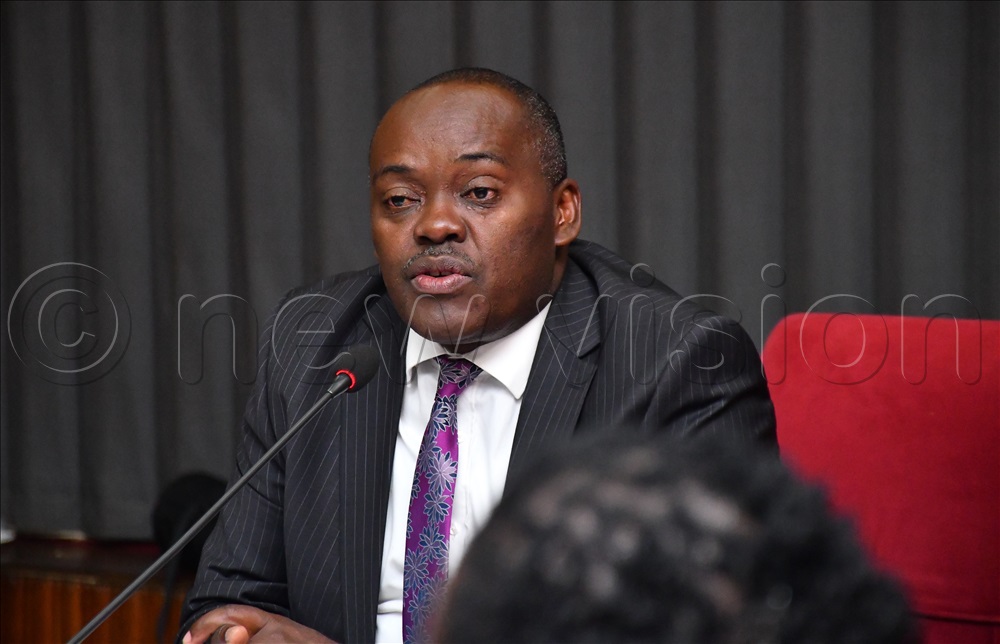Cost-cutting reforms to save Uganda Airlines over sh9b, Parliament told
While presenting, Bamuturaki said the biggest loss driver was fuel costs, followed by depreciation and crew allowances, all of which have significantly affected the airline’s operational performance.
The Executive Director Uganda Airlines Jennifer Bamuturaki responding to queries in the Auditor General's Report before COSASE on Thursday. (Photos by Namayanja Edith)
________________
In a bid to cut losses, Uganda National Airlines Company Limited (UNACL) is in talks with a new spare parts supplier, a move the entity’s chief executive officer (CEO), Jennifer Bamuturaki, says will significantly reduce expenditure.
Bamuturaki revealed the arrangement on Thursday, August 14, 2025, during an interaction with MPs on the Committee on Commissions, Statutory Authorities and State Enterprises (COSASE) chaired by Busiro East MP Medard Lubega Ssegona (NUP).
Discussions centred on the Auditor General’s (AG) report on the entity for the year ended December 2024, in which AG Edward Akol noted that despite witnessing a 26.5 per cent reduction in losses, the company still posted a sh237.855 billion net loss during the year under review.
In comparison, it had incurred sh323.5 billion in losses the previous year and sh265.9 billion in the 2021/22 financial year.
While presenting, Bamuturaki said the biggest loss driver was fuel costs, followed by depreciation and crew allowances, all of which have significantly affected the airline’s operational performance.
She added that internally, the carrier is working to address these challenges by “renegotiating contracts to the bone” and removing contentious clauses. One key focus, she noted, is on spare parts supply agreements.
New spare parts supplier
“One of our suppliers, Lufthansa Technik, has been providing us spare parts for the CRJs but they have now informed us, they are not going to support the CRJ as an aircraft. That means we had to go back to the market and look for companies that can support that aircraft,” Bamuturaki disclosed.
“One of the companies we have approached is an American company which will give us a significant reduction of about $100,000 (equivalent to sh356.8 million) a month. Because with Lufthansa and other spare parts suppliers, we have to pay a monthly retainer.”
The chairperson COSASE Medard Lubega Ssegona. 
Lufthansa Technik is a maintenance, repair and overhaul (MRO) subsidiary of the Lufthansa Group. It is one of the world’s largest and most reputable aircraft maintenance companies, providing routine maintenance, component repairs, aircraft modifications, and engineering services.
Cargo handling
She added that another cost-cutting strategy is self-handling. When UNACL resumed operations in 2019, it relied on Entebbe Handling Services (ENHAS), DAS and at one point Menzies Aviation Uganda (MAU), formerly National Aviation Services Uganda (NASU), for ground handling services.
However, since taking over the function in-house, the airline has saved about $250,000 (equivalent to sh850 million).
She noted that other costs stemmed from the Approved Maintenance Organisation (AMO), the certified workshops that keep aircraft safe and airworthy.
Bamuturaki told MPs that Uganda Airlines now has its own team of engineers, including several Ugandans who have returned home, maintaining the CRJ fleet in-house.
“In the past, we had SAMCO which was a supplier handling CRJ maintenance. When the contract ended, we took it on and got approval from CAA. We saved about €2 million (equivalent to sh7.8 billion) annually from that process,” Bamuturaki said.
Hoarding vice
However, COSASE chairperson Medard Lubega Ssegona questioned why the Canadian firm Bombardier Aerospace, which manufactured the national carrier’s regional jetliners, is not providing for its spare parts needs.
“What is the trouble with dealing with the manufacturer and probably the people who negotiated the purchase? Wouldn’t we have catered for that in negotiations? I mean, maintenance, supply of spares and so forth. Is there still production of CRJs globally?” Ssegona asked.
This prompted Bamuturaki to respond that the CRJ aircraft are no longer in production.
“Bombardier sold to Mitsubishi, everything to do with CRJ,” she stated.
She added that the spare parts challenge has been worsened by supply chain disruptions in the global market, a phenomenon that has resulted in hoarding.
“These spare parts are hoarded, and we have processes internally to be able to release, for example, what we call an AOG, which is an Aircraft on Ground. It has specific timelines; it should be on the ground, depending on whether you will be able to find the spare parts or if the team has been able to troubleshoot and find out the problem within that time frame,” she explained.
“Under normal circumstances, it should be 72 hours. That means you are also able to get the spare part either in the store or order for it from people that have credit, for example, Lufthansa. Sometimes we find that those spare parts are not available because they are hoarded, and by the time you process the monies, the prices have gone up and someone else has picked it up,” Bamuturaki added.
MPs react
A number of lawmakers, including Kashari South MP Nathan Itungo (Independent), argued that those who negotiated the Bombardier deal need to be held to account.
“Our Constitution is very clear. On matters of accountability, one can be called to account even when one has ceased office. So, through you, can we know the team that participated in the procurement? If need be, Mr Chairman (Ssegona), use your powers under Article 90 to summon whoever was in charge to come and account,” Itungo said.
It was noted that the CEO of UNACL at the time of the aircraft deal was Ephraim Bagenda.
Future of CRJ
The future of the CRJ fleet is also uncertain. According to Bamuturaki, many regional competitors operating the same type of aircraft are phasing them out at between ten and twelve years of service.
While Uganda’s CRJs, manufactured in 2017, still have some years left, she said it will be an uphill task to find another aircraft type with similar specifications.
“It’s a plane that fits the short regional routes. Because a 75-seater jet is fast enough and stable too,” Bamuturaki said.